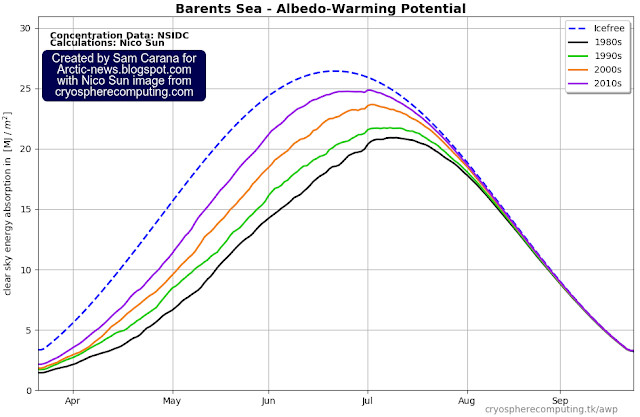On July 25, 2023, the North Atlantic sea surface reached a record high temperature of 24.9°C. The previous record was in early September 2022, when the temperature peaked at 24.89°C, according to NOAA scientist Xungang Yin and as illustrated by the image below.
In previous years, a La Niña was suppressing temperatures, whereas El Niño is now pushing up temperatures. Arctic sea ice typically reaches its minimum extent about half September. We are facing huge sea ice loss over the coming weeks.
Temperatures are very high (and rising) and the following eight points contribute to this rise:
1. Emissions are high and greenhouse gas levels keep rising, and this is increasing Earth's Energy Imbalance. Oceans take up 89% of the extra heat.
2. El Niño is pushing up temperatures, whereas in previous years La Niña was suppressing temperatures. Moving from the bottom of a La Niña to the peak of a strong El Niño could make a difference of more than half a degree Celsius, as discussed in an earlier post.
In February 2016, when there was a strong El Niño, the temperature on land was 3.28°C (5.904°F) hotter than 1880-1896, and 3.68°C (6.624°F) hotter than February 1880 on land. Note that 1880-1896 is not pre-industrial, the difference will be even larger when using a genuinely pre-industrial base.
If this trend continues, the rise in sunspots forcing from May 2020 to July 2025 may well make a global temperature difference of more than 0.25°C, a recent analysis found.
4. A submarine volcano eruption near Tonga in January 2022 did add a huge amount of water vapor to the atmosphere, as discussed in an earlier post and also at facebook.
5. Aerosol changes are also contributing to the temperature rise, such as less Sahara dust than usual and less sulfur aerosols that are co-emitted with fossil fuel combustion, which previously masked the full impact of greenhouse gases.
8. Increased stratification, as temperatures rise, combines with increased meltwater and with stronger evaporation over the North Atlantic and stronger precipitation further down the path of the Gulf Stream. This threatens to result in the formation of a freshwater lid on top of the North Atlantic, enabling more hot water to flow underneath this lid into the Arctic Ocean, further increasing the methane threat.
These are just three out of numerous developments that could unfold in the Arctic soon, such as tipping points getting crossed and feedbacks starting to kick in with greater ferocity, as discussed in an earlier post.
 |
| Latent heat loss, feedback #14 on the Feedbacks page |
Syee Weldeab et al., in a 2022 study, looked at the early part (128,000 to 125,000 years ago) of the penultimate interglacial, the Eemian, when meltwater from Greenland caused a weakening of the Atlantic meridional overturning circulation (AMOC). “What happens when you put a large amount of fresh water into the North Atlantic is basically it disturbs ocean circulation and reduces the advection of cold water into the intermediate depth of the tropical Atlantic, and as a result warms the waters at this depth,” he said. “We show a hitherto undocumented and remarkably large warming of water at intermediate depths, exhibiting a temperature increase of 6.7°C from the average background value,” Weldeab said.
Weldeab and colleagues used carbon isotopes (13C/12C) in the shells of microorganisms to uncover the fingerprint of methane release and methane oxidation across the water column. “This is one of several amplifying climatic feedback processes where a warming climate caused accelerated ice sheet melting,” he said. “The meltwater weakened the ocean circulation and, as a consequence, the waters at intermediate depth warmed significantly, leading to destabilization of shallow subsurface methane hydrates and release of methane, a potent greenhouse gas.”
Conclusion
The situation is dire and is getting more dire every day, which calls for a Climate Emergency Declaration and implementation of comprehensive and effective action, as described in the Climate Plan with an update at Transforming Society.
https://earth.nullschool.net
• Climate Reanalyzer - sea surface temperature
https://climatereanalyzer.org/clim/sst_daily
• Copernicus
https://climate.copernicus.eu
• University of Bremen - Arctic sea ice
https://seaice.uni-bremen.de/start
• A Prehistoric Climate Feedback Loop - Paleoclimatologist uncovers an ancient climate feedback loop that accelerated the effects of Earth's last warming episode (news release)
• NOAA - Global Monitoring Laboratory - Barrow, Alaska
https://gml.noaa.gov/dv/iadv/graph.php?code=BRW&program=ccgg&type=ts
https://arctic-news.blogspot.com/p/threat.html
• Moistening Atmosphere
https://arctic-news.blogspot.com/p/moistening-atmosphere.html
• Albedo, latent heat, insolation and more
https://arctic-news.blogspot.com/p/albedo.html
• Latent Heat
https://arctic-news.blogspot.com/p/latent-heat.html
• Blue Ocean Event
https://arctic-news.blogspot.com/p/blue-ocean-event.html
• Climate Plan
https://arctic-news.blogspot.com/p/climateplan.html
• Will there be Arctic sea ice left in September 2023?
• Dire situation gets more dire every day
https://arctic-news.blogspot.com/2023/07/dire-situation-gets-more-dire-every-day.html
• Transforming Society
https://arctic-news.blogspot.com/2022/10/transforming-society.html
• Climate Emergency Declaration
https://arctic-news.blogspot.com/p/climate-emergency-declaration.html













































